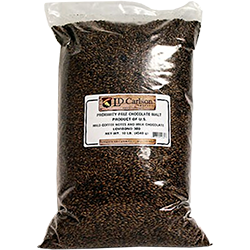The Essential Guide to Using Dark Malts in Home Brewing
Posted by Matteo Lahm on 16th Jan 2025
You're here because you've got a burning desire to know more about the grains that make your favorite stout and porter beers.
The grains you choose for your beer are like the foundation of a house. For stouts and porters, you're looking at darker, more robust grains. Think chocolate malt, black malt, and roasted barley. These grains are roasted until they're as dark as your ex's heart, and they give your beer that rich, dark color and deep, roasted flavor.
These grains are made with a process as old as time, or at least as old as beer making. The grains are soaked in water, allowed to germinate, and then dried in a kiln. This process, known as malting, develops the enzymes needed for fermentation. But for our dark grains, there's an extra step. They're roasted at high temperatures to achieve that dark color and rich flavor. It's like roasting coffee beans, but for beer.
These malts are similar, but they do have important distinctions. First up, the chocolate malt, and don't let the name fool you. There's no actual chocolate involved. The name comes from the deep brown color the malt takes on after roasting. The process starts with green malt, which is malt that has been allowed to germinate but not yet dried. This green malt is then roasted at temperatures around 350-500°F. The high heat caramelizes the sugars in the malt, resulting in a rich, chocolatey flavor. The longer the malt is roasted, the darker it becomes and the more intense the flavor.
Next, we have black malt. This malt is the darkest of the dark, roasted at temperatures upwards of 500°F until it's nearly black. The extreme heat breaks down the sugars in the malt, creating a bitter, burnt flavor. This malt is used sparingly in beer recipes, as it can easily overpower other flavors. But when used correctly, it can add depth and complexity to your stout or porter.
Lastly, we have brown malt. This malt is a bit lighter than the others, roasted at temperatures around 300-350°F. The lower heat results in a malt that's more toasted than roasted, with a nutty, slightly sweet flavor. This malt is perfect for porters, adding a subtle richness without overpowering the beer.
So, there you have it. The creation of dark malts involves controlled temperatures and time, each step carefully calibrated to draw out the desired flavors. Whether you're going for the rich sweetness of chocolate malt, the intense bitterness of black malt, or the subtle nuttiness of brown malt, remember that it's all in the roast.
Now that you understand the difference between these males, let's talk about how you use them in the mashing process. For stouts and porters, you're looking at a process called decoction mashing. This involves boiling a portion of the grains and then returning them to the mash, increasing the temperature. This process intensifies the malt flavors, giving your beer that robust, malty backbone.
However, the type of malt you're using can influence how you approach this process. For instance, when using chocolate malt or black malt, you might want to adjust your decoction process. Because these malts have already undergone significant flavor development through roasting, a full decoction might risk over-extracting and could lead to overly bitter or burnt flavors in your beer. In this case, you might opt for a single decoction or even a simple infusion mash, where the grains are steeped in hot water without the additional boiling step.
On the other hand, when using brown malt, which has a more subtle flavor, a full decoction mash can be beneficial. The boiling step can help to extract more of the malt's nuanced flavors, contributing to the complexity of your porter.
The mashing process is about understanding your ingredients and how they interact, and then using that knowledge to create the best beer possible. So don't be afraid to experiment and find the process that works best for your brew. After all, that's part of the fun!
Specific grain styles are relative to the kind of beer you are making. For your stout, you might want to consider using chocolate malt. This malt is roasted until it's dark brown, almost black, and it imparts a rich, chocolatey flavor to your beer. Think Guinness, that iconic Irish stout. They use a blend of chocolate malt and roasted barley to achieve that distinctive flavor. For your porter, you might want to consider using brown malt. It's the backbone of many traditional English porters, like Fuller's London Porter.
Of course, beer making is an art, and a science. You have your own individual taste and you will make your beer accordingly. Experiment with different grains, different roasting levels, and different mashing processes. You never know until you try.
So there you have it, your crash course in the grains used for stout and porter beers. The grains you choose are the foundation of your beer. They set the tone, the flavor, and the color. Choose thoughtfully, experiment often, and always enjoy the process. Because at the end of the day, it's not just about the beer you make, it's about the beer you enjoy.



